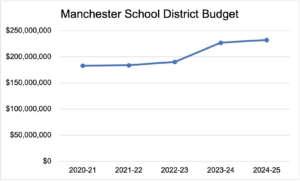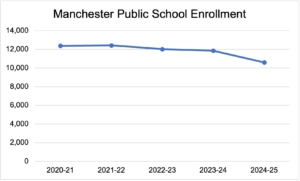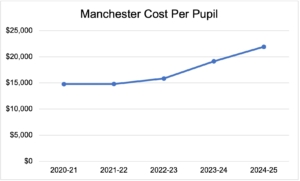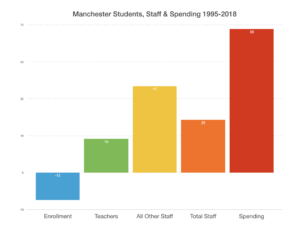Manchester school spending since 2020 goes way up as enrollment falls
The Manchester school district’s proposed 2025 budget continues the city’s trend of spending more to teach fewer students.
The district is asking for $232,227,530 for its 2024–25 school year budget. That’s an increase of $49,175,526, or 26.9%, since 2020–21. Even after adjusting for inflation,* the increase is still $16,967,892.80, or 7.9%, over the last four years.
*The inflation calculation assumes 2.8% inflation between December 2023 and January 2025, which is above what the Federal Reserve System is forecasting. This analysis, therefore, likely understates the real inflation-adjusted growth in Manchester’s public school spending in its proposed 2025 budget.
One might think that such a whopping spending increase must be tied to a correspondingly sharp increase in enrollment since 2021. On the contrary, enrollment in Manchester’s public schools as of October 2023 is 11,851 students, which is a drop of 529 students, or 4.3%, since 2020–21.
Under the proposed budget, Manchester would be spending $21,921 per pupil, which the district calculates using its enrollment in January 2024 of 12,024 students. (If fall enrollment is lower, as trends suggest, the cost per student would be higher than projected.)
The Manchester school district’s 2020–21 budget was $183,052,004 for its 12,380 students, which represented a cost per pupil of $14,786. The proposed $21,921 per student is an increase of $7,135, or $4,533 adjusted for inflation, from four years before. That’s an inflation-adjusted jump of 26.1% in less than five years.
Since the 2020–21 school year, the district’s budget ballooned thanks in large part to unprecedented federal spending as a result of the COVID-19 pandemic. The state also increased its per-pupil education aid last year.
Manchester’s school budget was $183,959,257 in 2021–22 and $190,328,128 in 2022–23. It jumped to $226,982,607 in 2023–24, with $20 million of that being capital spending for facilities improvement incorporated into the annual school budget.
The district added $20 million in the 2023–24 budget and another $20 million in the proposed 2024–25 budget to fund the first phase of the district’s long-term facilities plan. The school district is spending this money on facility upgrades for a declining student body, it should be noted.
While the budget has consistently grown, the number of students enrolled in Manchester public schools has consistently declined. In the years ahead, the student population is expected to continue falling. But spending continues to rise, and now the district seeks even more money to spend.

Meanwhile, the number of students enrolled in Manchester public schools has been declining.

As the district spends more money to educate fewer students, the cost per student rises sharply.

The city’s school district spending since 2021 continues the trend that dates back to the 1990s.
In previous research, we found that Manchester school district spending rose by 68% as enrollment fell by 13% from 1995–2018.

Similarly, we showed that Manchester enrollment fell by 22.3% while spending rose by 22.7% from 2001–2019 in our statewide education spending report last year.
Looking back to 2001, the increase in per-pupil spending is quite stark. Manchester spent $8,698 per pupil in 2001, adjusted for inflation, according to last year’s report. That’s $13,223 less than the $21,921 the district proposes to spend per student next school year.
For nearly three decades, Manchester taxpayers have spent ever-increasing sums of money, even after adjusting for inflation, on a steadily shrinking number of public school students.
Parents and voters might think they’ve bought better performance with all of that money.
In 2023, proficiency in English language arts, math, and science sat at 28%, 19%, and 14%, respectively—all in the bottom 25% in the state. Proficiency in English language arts has remained largely stagnant since 2021, while math proficiency rose by 5 percentage points and science proficiency declined by 3 percentage points.
The Manchester school district’s spending and test scores together reveal the flaw behind the idea that struggling school districts “just need more funding” to improve.
City residents might want to look into these budgets in more detail and ask city officials why shrinking class sizes and tens of millions of dollars in higher spending haven’t led to better academic results for students.


